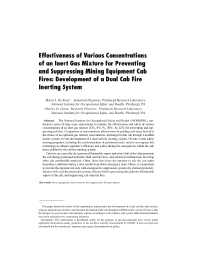Mining Publication: Effectiveness of Various Concentrations of an Inert Gas Mixture for Preventing and Suppressing Mining Equipment Cab Fires: Development of a Dual-Cab Fire Inerting System
Original creation date: March 2007
The National Institute for Occupational Safety and Health (NIOSH/PRL) conducted a series of large-scale experiments to evaluate the effectiveness and safety of various concentrations of an inert gas mixture (CO2, 8%; N2, 50%; Ar, 42%) for preventing and suppressing cab fires. Comparison of concentrations effectiveness in yielding safe times has led to the choice of an optimum gas mixture concentration, discharged in the cab through a muffled nozzle system, for the development of a dual cab fire inerting system. Of note is that safety training programs, including the synchronization of performed tasks, need to accompany this technology to enhance operator's efficiency and safety during fire emergencies within the safe times yielded by the cab fire inerting system. Cab fires are caused by the ignition of flammable vapors and mists (ball of fire) that penetrate the cab during prolonged hydraulic fluid and fuel fires, and electrical malfunctions involving other cab combustible materials. Often, these fires force the operator to exit the cab under hazardous conditions during a time needed to perform emergency tasks. Hence, it is important to provide the operator, not only with an engine fire suppression system (dry chemical powder), but also with a cab fire protection system, effective both in preventing the ignition of flammable vapors in the cab, and suppressing cab material fires.
Authors: MI DeRosa, CD Litton
Peer Reviewed Journal Article - March 2007
NIOSHTIC2 Number: 20031672
Fire Technol 2007 Mar; 43(1):29-44
See Also
- Evaluation of the Bagged Stone Dust Barrier Effectiveness in a Bord and Pillar Mine
- Inflatable Partitions for High-Expansion Foam Generators
- Innovative Strategies for Mine Fire Preparedness
- Mine Fires - Measuring the Efficacy of Gas-Enhanced Foam
- Performance-Based Fire Safety Designs for Self-Escape in Underground Mines
- Rapid Detection and Suppression of Mining Equipment Cab Fires
- Remote Mine Fire Suppression Technology
- The Status of Mine Fire Research in the United States
- Technical Solutions for Enhancements to Mine Safety Using Barricade II Fire Blocking Gel
- Understanding Mine Fire Disasters by Determining the Characteristics of Deep-Seated Fires
- Content source: National Institute for Occupational Safety and Health, Mining Program


 ShareCompartir
ShareCompartir
